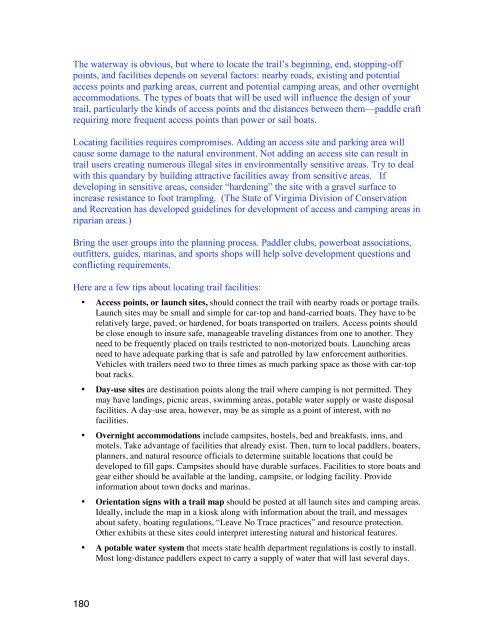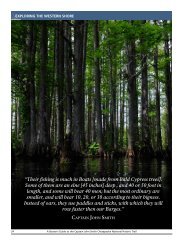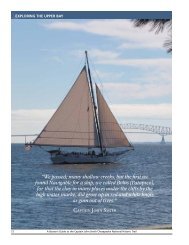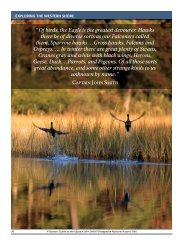Draft Interpretive Plan Join the adventure! - Captain John Smith ...
Draft Interpretive Plan Join the adventure! - Captain John Smith ...
Draft Interpretive Plan Join the adventure! - Captain John Smith ...
You also want an ePaper? Increase the reach of your titles
YUMPU automatically turns print PDFs into web optimized ePapers that Google loves.
The waterway is obvious, but where to locate <strong>the</strong> trail’s beginning, end, stopping-off<br />
points, and facilities depends on several factors: nearby roads, existing and potential<br />
access points and parking areas, current and potential camping areas, and o<strong>the</strong>r overnight<br />
accommodations. The types of boats that will be used will influence <strong>the</strong> design of your<br />
trail, particularly <strong>the</strong> kinds of access points and <strong>the</strong> distances between <strong>the</strong>m—paddle craft<br />
requiring more frequent access points than power or sail boats.<br />
Locating facilities requires compromises. Adding an access site and parking area will<br />
cause some damage to <strong>the</strong> natural environment. Not adding an access site can result in<br />
trail users creating numerous illegal sites in environmentally sensitive areas. Try to deal<br />
with this quandary by building attractive facilities away from sensitive areas. If<br />
developing in sensitive areas, consider “hardening” <strong>the</strong> site with a gravel surface to<br />
increase resistance to foot trampling. (The State of Virginia Division of Conservation<br />
and Recreation has developed guidelines for development of access and camping areas in<br />
riparian areas.)<br />
Bring <strong>the</strong> user groups into <strong>the</strong> planning process. Paddler clubs, powerboat associations,<br />
outfitters, guides, marinas, and sports shops will help solve development questions and<br />
conflicting requirements.<br />
Here are a few tips about locating trail facilities:<br />
• Access points, or launch sites, should connect <strong>the</strong> trail with nearby roads or portage trails.<br />
Launch sites may be small and simple for car-top and hand-carried boats. They have to be<br />
relatively large, paved, or hardened, for boats transported on trailers. Access points should<br />
be close enough to insure safe, manageable traveling distances from one to ano<strong>the</strong>r. They<br />
need to be frequently placed on trails restricted to non-motorized boats. Launching areas<br />
need to have adequate parking that is safe and patrolled by law enforcement authorities.<br />
Vehicles with trailers need two to three times as much parking space as those with car-top<br />
boat racks.<br />
• Day-use sites are destination points along <strong>the</strong> trail where camping is not permitted. They<br />
may have landings, picnic areas, swimming areas, potable water supply or waste disposal<br />
facilities. A day-use area, however, may be as simple as a point of interest, with no<br />
facilities.<br />
• Overnight accommodations include campsites, hostels, bed and breakfasts, inns, and<br />
motels. Take advantage of facilities that already exist. Then, turn to local paddlers, boaters,<br />
planners, and natural resource officials to determine suitable locations that could be<br />
developed to fill gaps. Campsites should have durable surfaces. Facilities to store boats and<br />
gear ei<strong>the</strong>r should be available at <strong>the</strong> landing, campsite, or lodging facility. Provide<br />
information about town docks and marinas.<br />
• Orientation signs with a trail map should be posted at all launch sites and camping areas.<br />
Ideally, include <strong>the</strong> map in a kiosk along with information about <strong>the</strong> trail, and messages<br />
about safety, boating regulations, “Leave No Trace practices” and resource protection.<br />
O<strong>the</strong>r exhibits at <strong>the</strong>se sites could interpret interesting natural and historical features.<br />
• A potable water system that meets state health department regulations is costly to install.<br />
Most long-distance paddlers expect to carry a supply of water that will last several days.<br />
180








